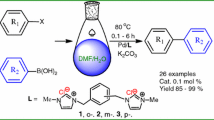Conclusions
Palladium chloride which is a catalyst for the preparation of phenylisocyanates by the carbonylation of nitro compounds is promoted by pyridine and its homologs and also by transition-metal oxides, which provide for the conversion of nitro compounds into phenyl-, methylphenyl-, and chlorophenylisocyanates in 75–92% yield and 84–97% selectivity at 200°C and 50–100 atm CO.
Similar content being viewed by others
Literature cited
E. Kober, W. Schnabel, and P. Hammond, French Patent No. 1,558,898 (1969); Chem. Abstr.76, 43191 (1970).
D. Dodman, K. Pearson, and J. Woolley, West German Application No. 1,901,202 (1969); Chem. Abstr.,71, 123894 (1969).
A. F. Igbal, Chem. Technol.,4, 566 (1974).
O. V. Krylov, Catalysis by Non-Metals [in Russian], Khimiya, Leningrad (1967), p. 146.
B. K. Nefedov, V. I. Manov-Yuvenskii, and S. S. Novikov, Dokl. Akad. Nauk SSSR,274, 1343 (1977).
B. K. Nefedov and V. I. Manov-Yuvenskii, Izv. Akad. Nauk SSSR, Ser. Khim., 2597 (1977).
Author information
Authors and Affiliations
Additional information
Translated from Izvestiya Akademii Nauk SSSR, Seriya Khimicheskaya, No. 3, pp. 585–589, March, 1979.
Rights and permissions
About this article
Cite this article
Nefedov, B.N., Manov-Yuvenskii, V.I. The effect of pyridine bases and transition-metal oxides on the activity of PdCl2 in the carbonylation of aromatic mononitro compounds by carbon monoxide. Russ Chem Bull 28, 540–543 (1979). https://doi.org/10.1007/BF00924828
Received:
Issue Date:
DOI: https://doi.org/10.1007/BF00924828



